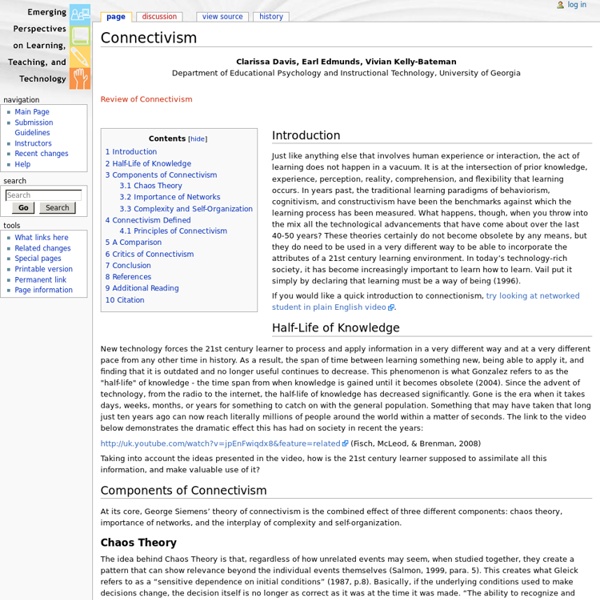CINE 2011. CLASIFICACION INTERNACIONAL NORMALIZADA DE LA EDUCACION
Emerging Perspectives on Learning, Teaching and Technology
Conectivismo en el aula: Educared 2011
Conectivismo en el aula: Educared 2011 Detalles Creado en Domingo, 06 Noviembre 2011 07:20 Visto: 7233 Conectivismo... En septiembre recibí la petición de la Fundación Telefónica de preparar una ponencia virtual para el encuentro de EducaRed de este año sobre la integración del Conectivismo en el Aula. Me resultó curioso que me hicieran esta petición, ya que en las redes me muestro bastante crítica con el Conectivismo. IV Encuentro Internacional EducaRed 2011 He recogido en el vídeo y en la presentación las ideas principales: ¡Muchas gracias a José Gregorio del Sol por ayudarme a grabar este vídeo! Después, charlamos sobre algunos temas en los foros. ¿Es el conectivismo una teoría? Como apunto en la presentación, desde mi punto de vista, el conectivismo es un concepto interesante pero no una teoría de aprendizaje. "¿Es el conectivismo una teoría? ¿Cómo se diferencian el conexionismo y el conectivismo? Desde mi punto de vista, al conectivismo se le puede achacar lo mismo que al conexionismo:
Conectivismo: Creatividad e innovación en un mundo complejo
El pasado mes de noviembre se celebró el encuentro internacional de Fundación Telefónica. Fué una experiencia muy enriquecedora, por la innovación, el despliegue tecnológico, la calidad de las ponencias principales (como la de George Siemens) así como el gran trabajo de la Fundación Telefónica. En esencia, el conectivismo sostiene que el conocimiento se distribuye a través de una red de conexiones, y por lo tanto, que el aprendizaje consiste en la capacidad de construir y atravesar esas redes. El conectivismo comparte con otras teorías una proposición principal, que el conocimiento no se adquiere, sino que se tratara de un objeto. El conocimiento conectivo se cultiva, no se construye, es natural, no intencional, y es inherente, no representativa. El conocimiento es, según esta teoría, literalmente, el conjunto de conexiones formadas por acciones y la experiencia. A continuación comparto el resumen de lo aprendido con Georges Siemens, padre de la teoría del conectivismo:
Qu'est-ce que le connectivisme ?
Les théories et les modèles de l'apprentissage se suivent et ne se ressemblent pas forcément; chacun présente une approche spécifique avec ses avantages et ses limites et on n'a pas toujours intérêt à adopter inconditionnellement l'une ou l'autre de ces approches. Le modèle transmissif où l'enseignant est le détenteur du savoir et s'évertue à le transmettre à un apprenant qui aspire à correspondre à un modèle a vu ses beaux jours décliner quoiqu'il soit encore appliqué dans des bastions réfractaires tels que certains espaces universitaires traditionnels (et les xMoocs). Le béhaviorisme, avec le balisage de l'apprentissage du plus simple au plus complexe avec force renforcements, positifs et/ou négatifs, des informations fournies juste à temps à l'apprenant et les remédiations pertinentes qui récupèrent tout retardataire vivra encore de très beaux jours et amènera des réussites ponctuelles satisfaisantes. Toutes ces approches correspondent à des pratiques courantes dans l'apprentissage.
Aprendizaje Invisible
Peer-to-Peer Learning Handbook | Peeragogy.org
Connectivism: A Learning Theory for the Digital Age
Connectivism: A Learning Theory for the Digital Age December 12, 2004 George Siemens Update (April 5, 2005): I've added a website to explore this concept at www.connectivism.ca Introduction Behaviorism, cognitivism, and constructivism are the three broad learning theories most often utilized in the creation of instructional environments. Learners as little as forty years ago would complete the required schooling and enter a career that would often last a lifetime. “One of the most persuasive factors is the shrinking half-life of knowledge. Some significant trends in learning: Many learners will move into a variety of different, possibly unrelated fields over the course of their lifetime. Background Driscoll (2000) defines learning as “a persisting change in human performance or performance potential…[which] must come about as a result of the learner’s experience and interaction with the world” (p.11). Driscoll (2000, p14-17) explores some of the complexities of defining learning. Conclusion:
Éxito en E-Learning
La educación a través de medios electrónicos es muy nueva como para decir que ya hay expertos en el tema, sin embargo si se pueden determinar algunos procesos que han sido exitosos y tratar de aprender de lo que se ejecutó en los mismos. El E-Learning se ha abierto camino contra viento y marea en el uso de las tecnologías digitales para llevar a cabo procesos de capacitación. La importancia del e-learning en cada empresa depende de su tipo y tamaño. El uso del e-learning o la educación a distancia por medios electrónicos brinda dos elementos altamente deseables. La educación a través de medios electrónicos es muy nueva como para decir que ya hay expertos en el tema, sin embargo si se pueden determinar algunos procesos que han sido exitosos y tratar de aprender de lo que se ejecutó en los mismos. Se debe dar igual importancia al método de evaluación, y no tanto para ser utilizado por terceros sino por el mismo estudiante.



